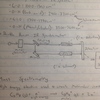Analytical and Biochemistry Flashcards
(110 cards)
What are the three main uses of Analytical techniques?
Determination of: Structure, Composition, and Purity
What are the three spectroscopic techniques?
IR, NMR, and Mass spectroscopy
Radiowaves do what to atoms?
NMR, change in orientation of nucleus relative to magnetic field
Microwaves di what to atoms?
Rotational transition
IR waves do what to atoms?
Vibrational transition
Visible light, UV light, and X-rays do what to atoms?
Electronic transitions in atoms and molecules (e- jump to new orbit)
What does every element have that is unique to it with regard to spectroscopy?
Idiosyncratic emission spectrum
What is IR Active?
A molecule is able to absorb IR radiation
What types of vibrations (IR) do diatomic molecules have?
Vibrations that increase bond length
If HCl is hit with IR radiation, what will happen?
The H-Cl bond will length, increasing the dipole moment of the molecule
What happens to non polar, diatomic molecules that absorb IR radiation, such as F2, Cl2, or Br2?
Their bond lengths increase, but there is no increase in dipole moment
What are I2, Cl2, Br2, etc considered to be in terms of IR spec? What does this mean
IR inactive: they can absorb IR radiation but it will not affect their polarity, only lengthen their bonds.
What types of vibrational modes do Triatomic molecules have (IR)?
Stretching and Bending
What are the two types of IR stretches?
Symmetrical and Asymmetrical
Which types of stretches are IR active?
Asymmetrical always active. Symmetrical active only in polar substances. Bend always active.
What types of stretches are active in CO2?
Non polar. Asymmetric stretch and bend are IR active.
How many absorptions does CO2 have on an IR spectrum?
Two, one for Asymmetric Stretch and one for Bend.
What is a methylene group
R1-CH2-R2
How many vibrational modes does CH2 have? What are they?
Six: Asymmetric Stretch, Symmetric Stretch, Bend, Rock, Wag, and Twist
What is always true of an IR spectrum containing -OH of an alcohol?
It must have a complimentary C-O peak
What is the fingerprint region? What is its use?
The region below 1500 Cm-1. Unique to each molecule, used for identification
What is C-O’s IR band?
1000-1300 cm-1
What is O-H’s (carb acid) IR band?
2400-3200 cm-1
What is C=O’s IR band?
1700-1750 cm-1




